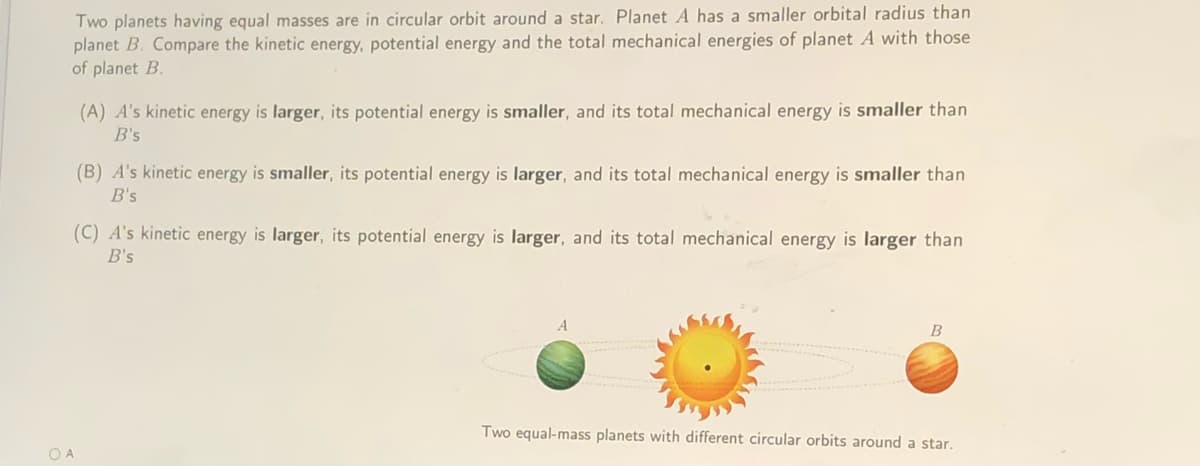How would the gravitational potential energy of planets A and B in the previous problem change if the star they were orbiting suddenly collapsed to half its size without its mass changing? (A) The gravitational potential would be four times larger (B) The gravitational potential would be two times larger (C) The gravitational potential would not change (D) The gravitational potential would be half as large (E) The gravitational potential would be one fourth as large
How would the gravitational potential energy of planets A and B in the previous problem change if the star they were orbiting suddenly collapsed to half its size without its mass changing? (A) The gravitational potential would be four times larger (B) The gravitational potential would be two times larger (C) The gravitational potential would not change (D) The gravitational potential would be half as large (E) The gravitational potential would be one fourth as large
Physics for Scientists and Engineers: Foundations and Connections
1st Edition
ISBN:9781133939146
Author:Katz, Debora M.
Publisher:Katz, Debora M.
Chapter7: Gravity
Section: Chapter Questions
Problem 3PQ: For many years, astronomer Percival Lowell searched for a Planet X that might explain some of the...
Related questions
Question
100%
How would planets A and B’d gravitational Potential energy change if the star they were orbiting suddenly collapsed ti half its size without its mass changing?

Transcribed Image Text:How would the gravitational potential energy of planets A and B in the previous problem change if the star they
were orbiting suddenly collapsed to half its size without its mass changing?
(A) The gravitational potential would be four times larger
(B) The gravitational potential would be two times larger
(C) The gravitational potential would not change
(D) The gravitational potential would be half as large
(E) The gravitational potential would be one fourth as large

Transcribed Image Text:Two planets having equal masses are in circular orbit around a star. Planet A has a smaller orbital radius than
planet B. Compare the kinetic energy, potential energy and the total mechanical energies of planet A with those
of planet B.
(A) A's kinetic energy is larger, its potential energy is smaller, and its total mechanical energy is smaller than
B's
(B) A's kinetic energy is smaller, its potential energy is larger, and its total mechanical energy is smaller than
B's
(C) A's kinetic energy is larger, its potential energy is larger, and its total mechanical energy is larger than
B's
B
Two equal-mass planets with different circular orbits around a star.
O A
Expert Solution
This question has been solved!
Explore an expertly crafted, step-by-step solution for a thorough understanding of key concepts.
This is a popular solution!
Trending now
This is a popular solution!
Step by step
Solved in 2 steps with 2 images

Knowledge Booster
Learn more about
Need a deep-dive on the concept behind this application? Look no further. Learn more about this topic, physics and related others by exploring similar questions and additional content below.Recommended textbooks for you

Physics for Scientists and Engineers: Foundations…
Physics
ISBN:
9781133939146
Author:
Katz, Debora M.
Publisher:
Cengage Learning

University Physics Volume 1
Physics
ISBN:
9781938168277
Author:
William Moebs, Samuel J. Ling, Jeff Sanny
Publisher:
OpenStax - Rice University

College Physics
Physics
ISBN:
9781305952300
Author:
Raymond A. Serway, Chris Vuille
Publisher:
Cengage Learning

Physics for Scientists and Engineers: Foundations…
Physics
ISBN:
9781133939146
Author:
Katz, Debora M.
Publisher:
Cengage Learning

University Physics Volume 1
Physics
ISBN:
9781938168277
Author:
William Moebs, Samuel J. Ling, Jeff Sanny
Publisher:
OpenStax - Rice University

College Physics
Physics
ISBN:
9781305952300
Author:
Raymond A. Serway, Chris Vuille
Publisher:
Cengage Learning

Physics for Scientists and Engineers, Technology …
Physics
ISBN:
9781305116399
Author:
Raymond A. Serway, John W. Jewett
Publisher:
Cengage Learning

Glencoe Physics: Principles and Problems, Student…
Physics
ISBN:
9780078807213
Author:
Paul W. Zitzewitz
Publisher:
Glencoe/McGraw-Hill

Principles of Physics: A Calculus-Based Text
Physics
ISBN:
9781133104261
Author:
Raymond A. Serway, John W. Jewett
Publisher:
Cengage Learning